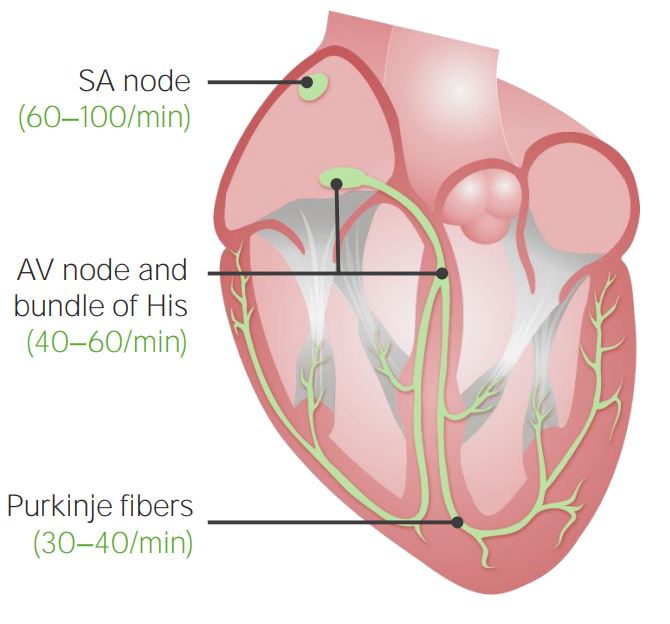Playlist
Show Playlist
Hide Playlist
Electrical Conduction System – Physiology of the Heart
-
Slides 02 Cardiology Alpert.pdf
-
Reference List Introduction to the Cardiac System.pdf
-
Download Lecture Overview
00:08 So, let’s start by following the heart through its contraction phase. 00:14 What you see here on the next three slides show the entire cycle that results in contraction and relaxation and filling of the heart. 00:25 What we see here in numbers 1, 2, 3, 4 and 5 is we see atrial systole on the right atrium and the left atrium, the tricuspid and mitral valves open, blood flows into the ventricles, and you can see the ventricle swelling and filling. 00:46 What you see now in number 6 through 10 is the ventricles begin to contract, the thin walled right ventricle and the thicker walled left ventricle. 00:57 tricuspid and mitral valves close, and the pulmonary valve and the aortic valve open as the two ventricles contract. 01:07 And then in the final sequence, they begin to relax again and the tricuspidand mitral valves open as blood flows into the ventricles to start another cycle. 01:21 And here, we see in this little motion diagram, the heart contracting. 01:27 You can see a little green pattern, that’s the electrical wave, passing down, starting at the right atrium, passing to the left atrium, down through the ventricular septum and out into the ventricular walls. 01:41 Can you see that the mitral and tricuspid valves open during diastole and then close and then the pulmonary and aortic valve are open during systole when the ventricles contract? Let’s talk a little bit about ventricular systole. 02:00 Ventricular systole is particularly important because that is, in fact, the pumping time of the heart. 02:08 Ventricular systole lasts for 0.3 seconds, every beat is the same 0.3 seconds. 02:15 So, you can see that when the heart rate accelerates, in each minute there becomes less time for diastole. 02:22 The ideal balance between systole and diastole occurs generally between heart rates of 60 to 90 per minute. 02:30 As we start to get above heart rates over a 100, we have the problem that diastole is progressively shortened, particularly at heart rates of 130, 140, 150 and unless you are a trained athlete, you may not fill the ventricles adequately and cardiac output- that is the pumping ability of the heart per minute, may actually go down a little bit. 02:54 The same thing happens with very, very slow heart rates. 02:57 The ventricles can only fill so much and therefore, you need a sufficient number of systoles during a minute to produce a good blood flow and a good blood pressure. 03:10 Here we see, actually, the start of ventricular systole on the right side with the blue blood and on the left side with the oxygenated red blood. 03:20 You can see that the right ventricular wall is much thinner than the left ventricular wall because it’s doing mostly volume work. 03:29 It’s pumping volumes of blood to the pulmonary artery at low pressure while on the left side, the piston like left ventricle is pumping the same volume of blood, but at a high pressure in order to get the blood to profuse throughout the body.
About the Lecture
The lecture Electrical Conduction System – Physiology of the Heart by Joseph Alpert, MD is from the course Introduction to the Cardiac System.
Included Quiz Questions
Where is the SA node located?
- Right atrium
- Left atrium
- Left ventricle
- Right ventricle
- Septum
Which of the following is NOT a part of the conduction system?
- The fossa ovalis
- The SA node
- The AV node
- The right and left bundle branches
Where is the AV node typically located?
- Right atrium
- Left atrium
- Right ventricle
- Left ventricle
- Aorta
Customer reviews
5,0 of 5 stars
| 5 Stars |
|
1 |
| 4 Stars |
|
0 |
| 3 Stars |
|
0 |
| 2 Stars |
|
0 |
| 1 Star |
|
0 |
The explanation was great. It was way better than my instructor's.




